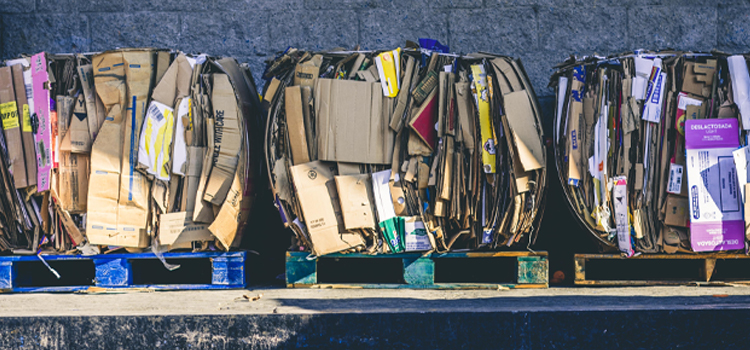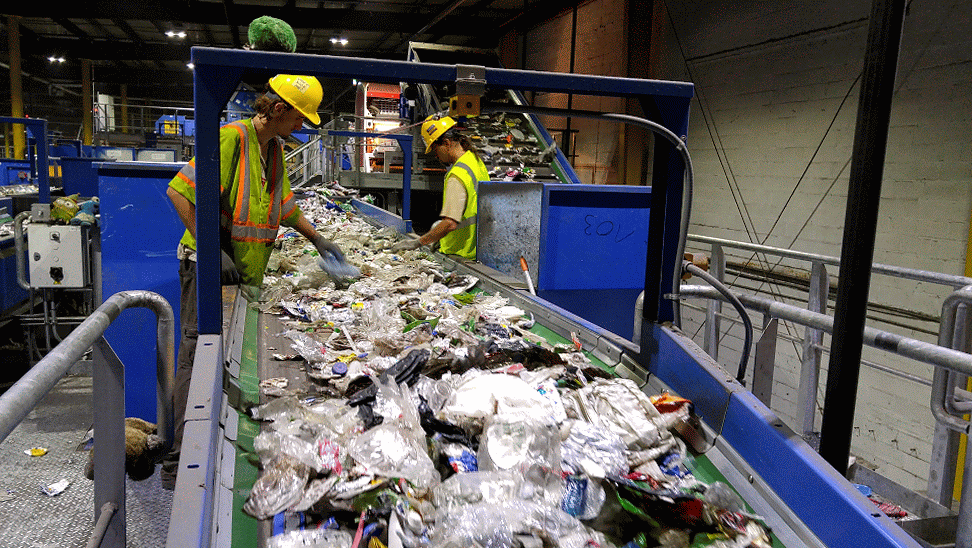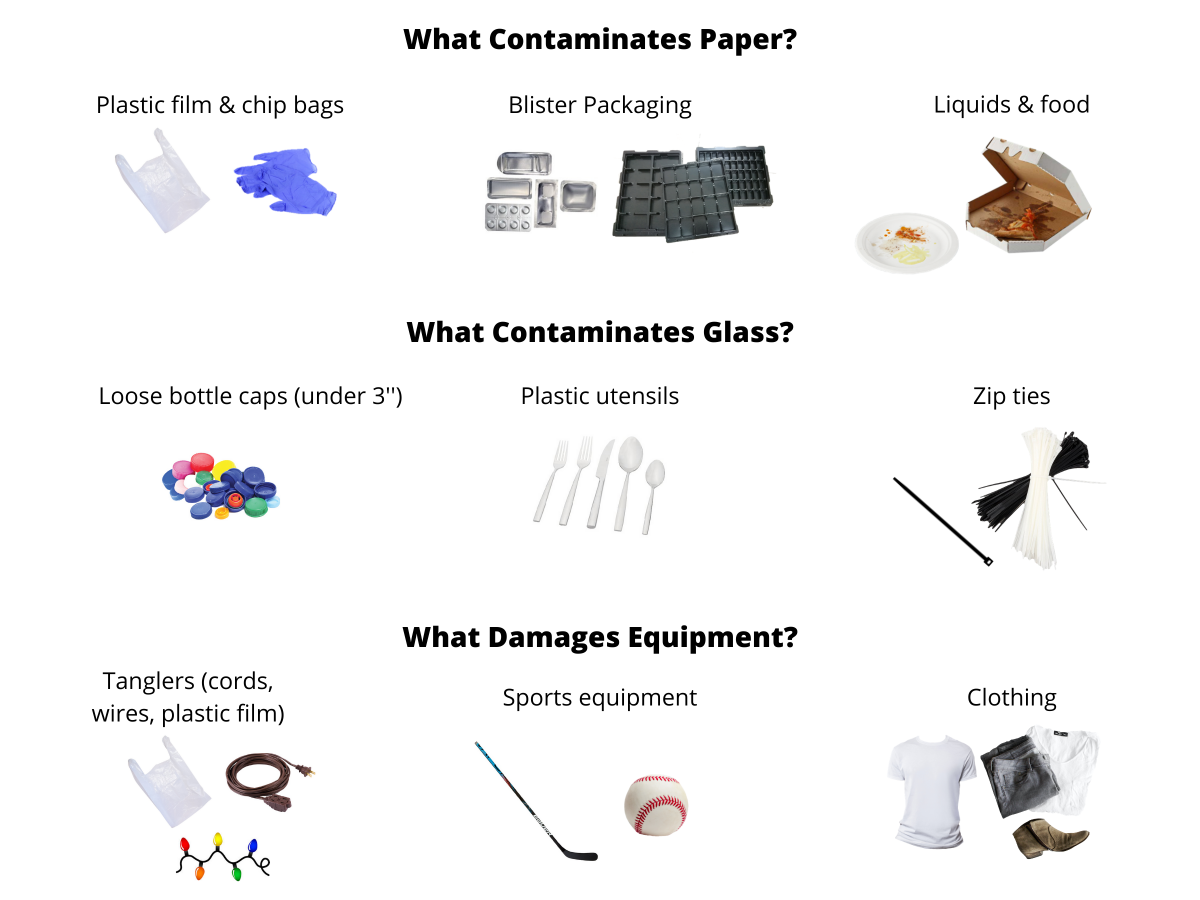
You're probably already familiar with the 3 R's: Reduce, Reuse and Recycle. And when we think about if something can be recycled, we usually think of the material as the main factor. Paper, check. Metal, check. Glass, check. Easy! Well, we'd love it if it was that easy. What determines if an item can be successfully recycled is actually more complicated. This is why recycling can seem so confusing.
Although we would love for every item to be thrown in the recycling bin, sorted, and then repurposed, it is only possible to recycle an item when it meets certain criteria. While you can check UW Recycling's Disposal Guide to see where an item should go, there are easy tricks you can do to figure out the right answer.
Introducing the 4 S's - an item can be placed in a regular mixed recycling bin if it meets these criteria:
- Sortable
- Supply
- Safe
- Sellable
Below is a description of each S, and why it's important in recycling:
Sortable
 Having one bin for recycling is great for saving space and increasing convenience for recyclers, but it is a complicated process once the contents of the bin are collected. Some recyclers even call it "unscrambling the egg." Mixed recycling is hauled to a Material Recovery Facility (MRF) to be sorted by people and specialized machinery. It's a system that can only sort common items with distinct traits.
Having one bin for recycling is great for saving space and increasing convenience for recyclers, but it is a complicated process once the contents of the bin are collected. Some recyclers even call it "unscrambling the egg." Mixed recycling is hauled to a Material Recovery Facility (MRF) to be sorted by people and specialized machinery. It's a system that can only sort common items with distinct traits.
A MRF has dozens of conveyor belts and screens moving and separating material. Paper and cardboard can be sorted because they're light and flat. Glass can be sorted because it's heavy and breaks into small pieces. Metals can be sorted with magnets and plastics are often sorted by shape, by hand and using lasers to identify valuable resin.
Plastics can be any weight, any size, any shape and any combination of resins. See the sorting problem? For more details on recycling plastics properly, check out our blog post.
Most of the hand-sorting at a MRF focuses on removing these common contaminants from the conveyor belts before and during the mechanical sorting process.

Supply
The specialized machinery in MRFs were created to handle most common recyclables. For example, plastic water bottles and metal food cans are easily recycled, so someone created specific machines in the MRF to sort those items correctly. Trying to recycle an uncommon object, such as molded plastic (think of toys or figurines) will end up contaminating other recycling.
When we throw something into the recycling bin and hope for the best (wish-cycling), we may cause more problems than we solve.
It is also important that the supply of a particular item doesn't change so it's worth long-term investments in sorting and manufacturing. This allows recyclers to establish steady buyers of the recycled material. For example, there will always be a steady flow of metal cans, but an occasional metallic water bottle is made of a different material composition. This item would likely need a different end-market. For these reasons, the supply of items entering a MRF is a crucial factor in determining an object's recyclability.
Safe
After an item is disposed in a recycling bin, it will be transported in multiple containers and vehicles. Many people will come into contact with it during the recycling process, including custodians, waste collectors, and sorters at the MRF. The human aspect of recycling is why certain items need to be treated with special care. Some common and potentially hazardous items are batteries, aerosol cans, lightbulbs or broken glass, and lab or medical containers.
It is very important to dispose of these items properly. Even when incorrectly placed in the landfill, these items pose a significant danger to the many people that come in contact with them after disposal. Please check out the disposal guide or the UW’s hazardous waste page with any questions about proper disposal for potentially hazardous items.
Sellable
Some items cannot be recycled because the material has little value for manufacturing into new goods. If manufacturers can't use the recycled material, it is not feasible for a MRF to sort it out. In these cases, we can avoid sending material to the landfill by choosing to reduce and reuse.
Plastic blister packaging (how batteries and scissors are often packaged) or chip bags are items that are not very useful or sellable. The material is too low-quality to be turned into a reliable new product. Furthermore, both of these materials are light and flat, which is mistaken for paper and contaminates recycling. If you can't avoid buying this type of plastic packaging, then placing it in the landfill is the next best option.
Other things to consider
When you recycle, you are a part of the manufacturing system. Doing your part to recycle correctly, with the 4 S's in mind and the willingness to look up a confusing item, allows recycling to continue as an option for our community.
When shopping, consider buying recycled products - items that are made from post-consumer content. This makes materials more valuable and more likely to get recycled in the future!
Keep in mind if an item isn't recyclable in the mixed recycling, it's a good idea to lean more on the Reduce and Reuse of the 3R's - consider whether is a necessary purchase, if there's something else you can reuse to avoid creating that waste, or if you can use reuse it for something else!
Thank you for doing your part and giving items new life! Please feel free to reach out to UW Recycling (recycle@uw.edu) with any questions.